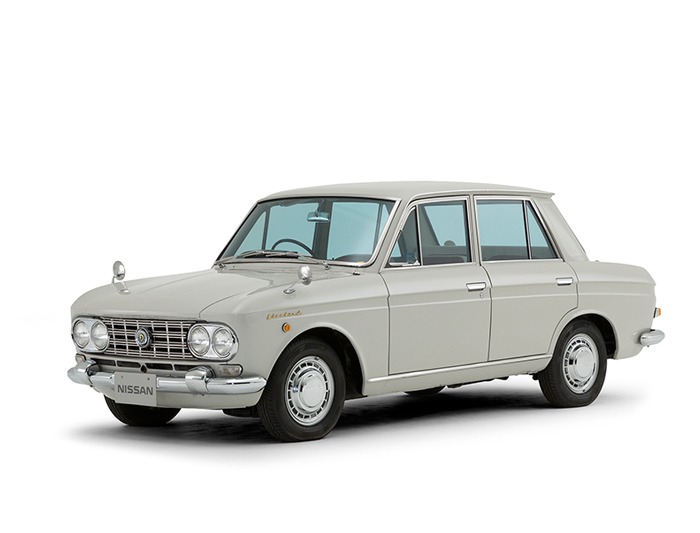

Datsun Bluebird
The Datsun Bluebird third series designed by Pininfarina.
Vehicle Overview
The Datsun Bluebird third series, notably designed by Pininfarina, stands as a testament to the convergence of Japanese automotive engineering and European aesthetic influences. Launched in September 1963, amidst Japan’s burgeoning automotive industry, this model marked a significant departure from its predecessors with its sleek European styling cues, reminiscent of the Lancia Fulvia, courtesy of Pininfarina’s design ethos. Timed to coincide with the 1964 Summer Olympics, Nissan strategically introduced the fully remodeled Bluebird to present a modern, cosmopolitan image to the world. The third series came in two distinct iterations: the 410 (1964–1965) and the 411 (1965–1967), each showcasing unique design elements, including a combination rear lamp set with round and rectangular lenses. Notably, the Bluebird broke new ground as one of the first Japanese car lines to be assembled in countries like New Zealand and South Africa, reflecting Nissan’s global ambitions. In New Zealand, the Bluebird quickly gained popularity, initially imported under specific tariff arrangements and later assembled locally, catering to the preferences of different markets. In its homeland of Japan, the Bluebird SS emerged as a sporting variant, boasting a tuned 1.2 L engine designed to appeal to enthusiasts seeking performance. With both four-door and two-door configurations available, the SS models embodied the spirit of Japanese engineering prowess, coupled with Pininfarina’s timeless design flair. The third series also witnessed significant advancements in engine technology, with variants like the 1200SS, 1300SS, and 1600SSS introduced in subsequent years, catering to diverse customer preferences. Moreover, the adoption of a monocoque body structure underscored Nissan’s commitment to enhancing both performance and structural integrity. For international markets, particularly the United States, the Bluebird was positioned as a practical yet stylish sedan and wagon, offering a range of engine options, including the robust 1.6-liter powerplant shared with the SP(L)311 Roadster. The inclusion of both manual and automatic transmissions further broadened its appeal among American consumers. Notably, the commercial variant of the Bluebird, labeled the 520, diverged from convention, reflecting Nissan’s strategic evolution in branding and product segmentation. This divergence marked a significant milestone in Datsun’s history, paving the way for future innovations and product developments. In essence, the Datsun Bluebird third series, with its collaboration with Pininfarina and its global reach, exemplified Nissan’s commitment to innovation, performance, and design excellence, leaving an indelible mark on the automotive landscape of the 1960s and beyond.

Technical Specifications
-
Body
-
Year1964
-
MakeDatsun
-
ModelBluebird
-
CoachbuilderPininfarina
-
Length (mm)3995
-
Width (mm)1490
-
Height (mm)1415
-
Units builtN/A
-
Engine TypeN/A
-
DesignerN/A
-
MakeN/A
-
ModelN/A
-
Cylinder CapacityN/A
-
Number Of DoorsN/A
-
Six Month RateN/A
-
Twelve Month RateN/A
-
Date Of First RegistrationN/A
-
Year Of ManufactureN/A
-
CO2 EmissionsN/A
-
Fuel TypeN/A
-
Tax StatusN/A
-
TransmissionN/A
-
ColourN/A
-
Type ApprovalN/A
-
Wheel PlanN/A
-
Revenue WeightN/A
-
Tax DetailsN/A
-
Mot DetailsN/A
-
TaxedN/A
-
motN/A
-
MakeN/A
-
Cylinder CapacityN/A
-
RegistrationN/A
-
Year Of ManufactureN/A
-
CO2 MissionsN/A
-
Fuel TypeN/A
-
Tax StatusN/A
-
ColourN/A
-
Type ApprovalN/A
-
Wheel PlanN/A
-
Revenue WeightN/A
RELATED VEHICLES
More vehicles by Pininfarina
Coachbuilder
- +39 011 943 8111
- info@pininfarina.it
- http://www.pininfarina.com/
Missing or wrong informations?
Carrozzieri-Italiani.com relies on thousend of users who help to populate the database. We do not guarantee the accuracy of the informations. Contact us if you want to contribute.



















